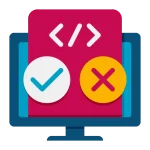Basic Input/Output in C++
Basic Input/Output
In this section, we will learn about the basic input/output commands in C++ using various methods.The input and output in C++ are performed in a sequence of bytes referred to as a stream. There are multiple libraries in C++ which helps us to use the basic input/output functions of c++. We will learn how to input and output basic elements and objects in C++.

Input/Output in C++
In C++ programming language, the two streams can be explained as follows :
Input Stream:
If the direction of flow of bytes is from the device(for example, Keyboard) to the main memory then this process is called input.
Output Stream:
If the direction of flow of bytes is opposite, i.e. from main memory to device( display screen ) then this process is called output.
Header Files for Input/Output in C++
There is a list given below of various header files which help in basic input/output operations in C++:
| Header File | Description |
|---|---|
| iostream | It stands for input/output stream. |
| iomanip | It stands for input/output manipulators. |
| fstream | It mainly describes the file stream. |
| bits/stdc++.h | It includes every standard library. |
Basic Input/Output methods in C++
In C++ programming language, some of the input/output methods are :
Standatrd Input Stream – cin command
- C++ cin statement is the instance of the class istream and is used to read input from the standard input device which is usually a keyboard.
- The extraction operator(>>) is used along with the object cin for reading inputs.
Standatrd Output Stream – cout command
- The C++ cout statement is the instance of the ostream class and is used to produce output on the standard output device which is usually the display screen.
- The data needed to be displayed on the screen is inserted in the standard output stream (cout) using the insertion operator(<<).
Un – buffered standard error stream – cerr command
- The C++ cerr is the standard error stream that is used to output the errors ands is also an instance of the iostream class.
- As cerr in C++ is un-buffered so it is used when one needs to display the error message immediately.
- It does not have any buffer to store the error message and display it later.
buffered standard error stream – clog command
- This is also an instance of ostream class and used to display errors but unlike cerr the error is first inserted into a buffer and is stored in the buffer until it is not fully filled. or the buffer is not explicitly flushed (using flush()).
Basic Input/Output commands in C++
Example 1:
#include<bits/stdc++.h>
using namespace std;
{
int roll;
cout << "Enter your roll number:"; cin >> roll;
cout << "\nYour roll number is: " << roll;
return 0;
}
Input:
18
Output:
Enter your roll number: Your roll number is: 18
Example 2:
#include<bits/stdc++.h> using namespace std; int main()
{
cerr << "An error occurred";
return 0;
}
Output:
An error occurred
Example 3:
#include<bits/stdc++.h>
using namespace std;
int main()
{
clog << "An error occurred";
return 0;
}
Output:
An error occurred
Prime Course Trailer
Related Banners
Get PrepInsta Prime & get Access to all 200+ courses offered by PrepInsta in One Subscription
Get over 200+ course One Subscription
Courses like AI/ML, Cloud Computing, Ethical Hacking, C, C++, Java, Python, DSA (All Languages), Competitive Coding (All Languages), TCS, Infosys, Wipro, Amazon, DBMS, SQL and others






Login/Signup to comment